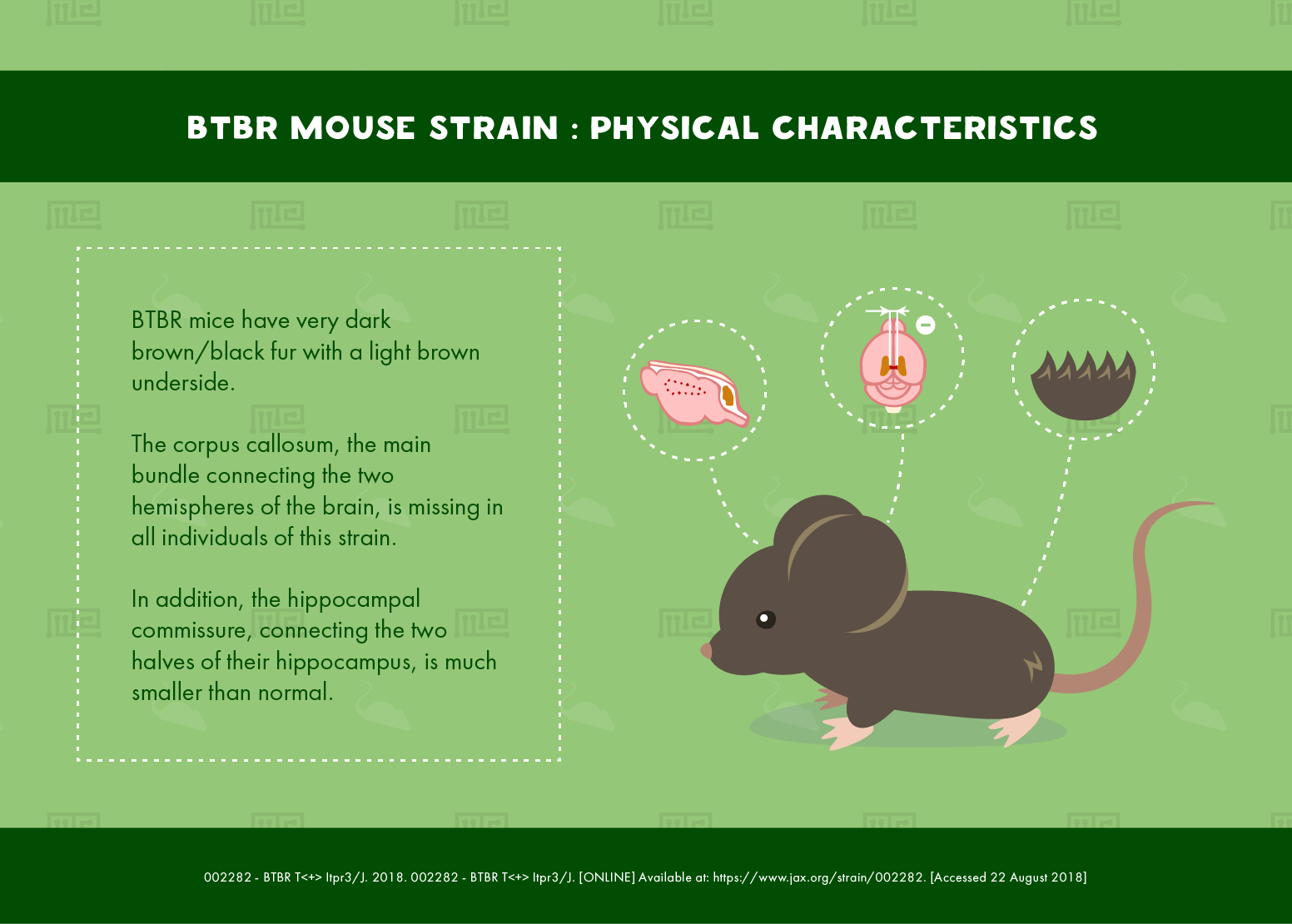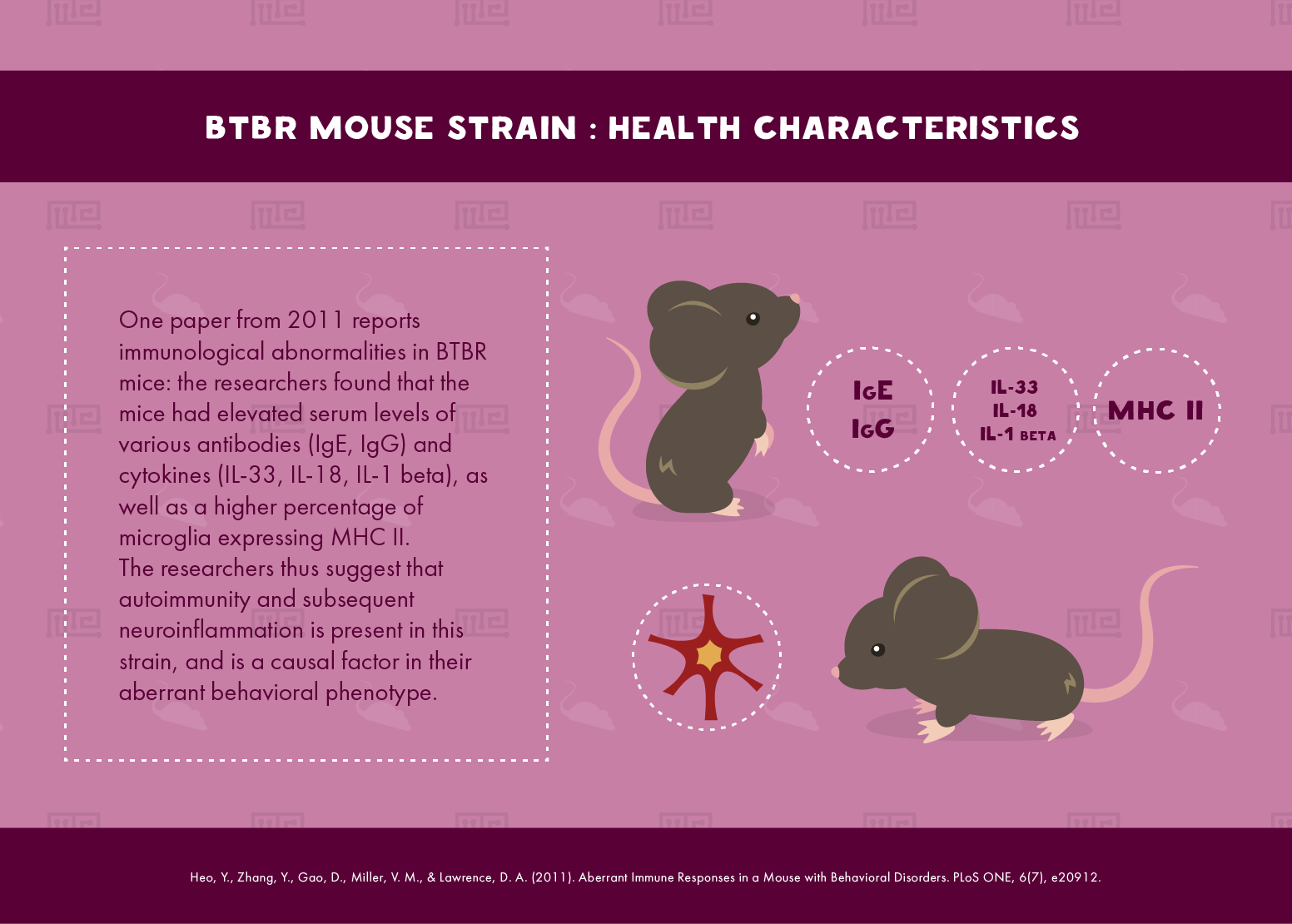Overview
BTBR, also known as BTBR T+ Itpr3tf/J, is a strain of mouse model that is most noted for its phenotypic similarities to humans on the autism spectrum. BTBR stands for “Black and Tan BRachyury”.
History
LC Dunn created the original BTBR strain from stock he obtained from Dobrovolskaia-Zavadskaia. The stock was intensely inbred at Columbia University during the 1950s, where the allele tufted was added as a marker.[1]
Dorothea Bennett received these mice in 1962 and continued the inbreeding before Karen Arzt took them from the Bennett laboratory to Guenet at the Pasteur Institute in 1974. In 1982, the mice passed to the McArdle laboratory in Wisconsin. They finally came to the Jackson Laboratory in 1994.[1]
Physical Characteristics
BTBR mice have very dark brown/black fur with a light brown underside. The corpus callosum, the main bundle connecting the two hemispheres of the brain, is missing in all individuals of this strain. In addition, the hippocampal commissure, connecting the two halves of their hippocampus, is much smaller than normal.[1]
Behavioral Characteristics & Handling
The most salient feature of the BTBR strain is its abnormal behavioral phenotype, which bears certain similarities to that of autistic humans. These mice show autism-like deficits in social interaction, play, vocalization, and grooming as well as repetitive behaviors.[1]
One study reports low social approach in BTBR mice, as well as unwillingness to change routine during the Morris water maze.[2] Another study focused on the behavior of BTBR and C57BL/6J mice in a natural-like burrowing environment; here the researchers report BTBR displaying low frequency of all forms of social interaction, as well as repetitive grooming behavior. The social deficit here was replicated in the three box test.[3]
While these observations make BTBR highly promising as a model for autism spectrum disorders, they also mean that researchers wanting to pursue other areas of study would likely be best choosing a different strain to work with.
Handling of this strain should not pose great difficulty. A Canadian study comparing the ease of handling of various commonly used strains reports that BTBR mice were quite placid, although less so than C57BL/6J and BALB/cByJ. Struggling when held and evasiveness during capture was occasionally seen, with intermediate squeaking frequency.[4]
Health Characteristics
One paper from 2011[5] reports immunological abnormalities in BTBR mice: the researchers found that the mice had elevated serum levels of various antibodies (IgE, IgG) and cytokines (IL-33, IL-18, IL-1 beta), as well as a higher percentage of microglia expressing MHC II. The researchers thus suggest that autoimmunity and subsequent neuroinflammation is present in this strain, and is a causal factor in their aberrant behavioral phenotype.
Major Experimental Uses
As detailed above, BTBR’s various behavioral abnormalities mean it is highly suitable for research into autism spectrum disorders. Its aberrant performance on the most commonly used behavioral tests also means it is not especially suitable for other applications. It is however of interest to those studying neurodevelopmental abnormalities, as well as skin and hair texture defects. Its lack of a corpus callosum also makes it similar to human “split-brain” patients, which may allow for research in that domain.
References
- 002282 – BTBR T<+> Itpr3/J. 2018. 002282 – BTBR T<+> Itpr3/J. [ONLINE] Available at: https://www.jax.org/strain/002282. [Accessed 22 August 2018].
- Moy, S. S., Nadler, J. J., Young, N. B., Perez, A., Holloway, L. P., Barbaro, R. P., … Crawley, J. N. (2007). Mouse Behavioral Tasks Relevant to Autism: Phenotypes of Ten Inbred Strains. Behavioral Brain Research, 176(1), 4–20.
- Pobbe, R. L. H., Pearson, B. L., Defensor, E. B., Bolivar, V. J., Blanchard, D. C., & Blanchard, R. J. (2010). Expression of social behaviors of C57BL/6J versus BTBR inbred mouse strains in the visible burrow system. Behavioral Brain Research, 214(2), 443–449.
- Wahlsten, D. Metten, P. Crabbe, JC. 2003. A rating scale for the wildness and ease of handling laboratory mice: results for 21 inbred strains tested in two laboratories. Genes, Brain and Behavior. 2; 71-79.
- Heo, Y., Zhang, Y., Gao, D., Miller, V. M., & Lawrence, D. A. (2011). Aberrant Immune Responses in a Mouse with Behavioral Disorders. PLoS ONE, 6(7), e20912.


